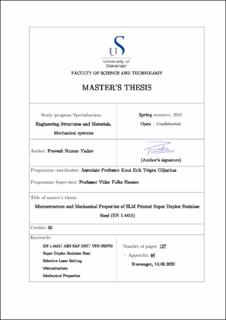| dc.description.abstract | The purpose of this study is to investigate the microstructural and mechanical characterization of super duplex stainless steel of grade EN 1.4410 / AISI SAF 2507 manufactured by selective laser melting (SLM). The findings offer insights on the phase arrangement of as-built conditions as well as various heat-treated temperatures. It also studies the effect of cooling rate on microstructure and mechanical properties of the material after heat treatment at different temperatures.
The heat treatment was applied on SDSS from 1000˚C to 1300˚C at the interval of 100˚C for 1-hour duration to restore the balanced duplex microstructure. Then, the material was cooled by two different methods, i.e., water quenching and air cooling, after heat treatment to check the effect of cooling rate. The microstructural analysis has performed using a Light optical microscope, scanning electron microscope (SEM), and transmission electron microscope (TEM). The material’s mechanical properties are studied by performing Vickers hardness test and pitting corrosion test of type ASTM G48.
The as-printed material was entirely ferritic, with barely a trace of austenite. All the elemental composition was within the standard SAF 2507 range in powder and in the as-printed sample except chromium, which was found out of range (about 27.5% wt.). Because of the specific laser scanning pattern, a unique macroscopic texture was formed. A mosaic-type macrostructure with tesserae of 123–126 μm was obtained after SLM in an as-printed sample. The grains inside each tessera had a different crystallographic orientation than grains in adjacent tesserae. The nano-sized dislocation loops were abundant in the as-printed material, both within the tesserae and within smaller recrystallized micron grains between the mosaic boundaries. TEM result also shows a decrease in dislocation density after heat treatment of SLM manufactured parts. The as-printed microstructure has a ferrite of about 94% and 99.6% using a light microscope and EBSD respectively. The nitrogen concentration ranged from 0.56-0.88 percent in the as-printed sample, indicating that nitride phases or nitrogen-enriched regions in the ferrite matrix might occur after fast cooling in heat-treated material.
At 1000˚C, the sigma phase was found about 14-15% in both water-quenched and air-cooled samples. But the sigma phases vanished after heat treatment temperature above 1100˚C. The chromium nitride was observed inside ferrite grain and at the grain boundary in all water quenched samples. As heat treatment temperature increased from 1000˚C to 1300˚C, the volume fraction of chromium nitrides has also increased from 1% to 5.5% approximately. It was challenging to avoid chromium nitrides precipitation even at higher temperatures by the water quenching method. So, heat treatment temperature should be kept as low as possible without risking precipitation of intermetallic phases.
The air cooling method provides precipitation-free and pure dual-phase microstructure at a temperature ranging from 1100-1300˚C, so air cooling is preferred for this material. The best phase balance was found at 1200˚C with about 61% δ-ferrite and 39% austenite. In water quenched sample, as HT temperature increases from 1000-1300˚C, the grain size of austenite grows larger, and the surrounding δ-ferrite band becomes wider. Similar was the case in the air-cooled sample too. But grain size of austenite was a little bigger in the air-cooled sample than the water quenched sample at the same temperature due to slow cooling.
The solid part of the sample was found harder than the hollow part. The sample surface parallel to the build direction is harder than the sample surface perpendicular to the build direction. The average hardness of as-built SAF 2507 is 417, and it decreases with heat treatment. The average hardness decreased in the material by 30-35% after heat treatment was carried out. The hardness of the material increases with an increase in the percentage of ferrite content and precipitates like sigma and chromium nitride.
No visible pits were observed in any sample while performing the ASTM G48 pitting corrosion test at room temperature of 22±2˚C for 72 hours.
It can be stated that the sample is not in a satisfactory dual-phase super duplex structure straight from production but rather an approximately fully ferritic microstructure. It clearly states that the material had to be processed before use, which leads to loss of time and money. The material holds more surprises, and it shows great promise as a standard engineering material. | |
